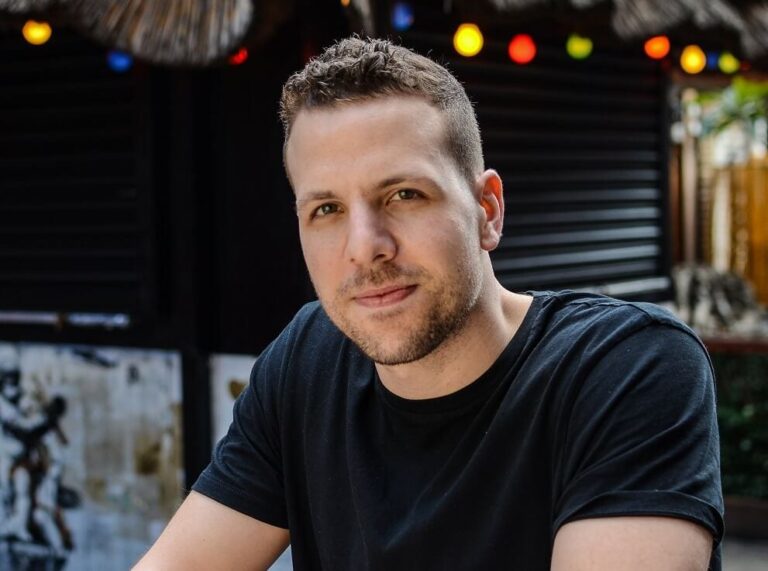Bes might not be as much of an internationally known name in the game as other Russian drum & bass counterparts such as Teddy Killerz or Enei. But know this: he is a bonafide Russian D&B pioneer.
One of the earliest D&B DJs in Russia, and the man behind the country’s first drum & bass label TAM Records, Bes has been involved in a unique national D&B movement in various capacities; a DJ, artist (both as a solo artist and as half of Gydra), label owner and host of the Neuropunk podcast that continues to attract millions of listeners every show.
Neck deep in Russian D&B since it began around the turn of the century, and responsible for debut releases from almost every Russian artist you can think of from Paul B to Paperclip, Bes has ardently flown the flag for his national scene. A scene that’s developed pretty much unnoticed by the rest of the junglist world for the first decade of its existence, besides breakthrough acts such as Dissident, Subwave and Sunchase. As a result, the country’s scene has incubated its own sound, community, eco system and vast waves of talent…
Which we’re beginning to experience more and more of as new Russian D&B acts hop aboard the global DJ merry-go-round on the daily. From Black Barrell to Gydra via Bop, Teddy Killerz, Aggressor Bunx, Receptor, Mizo and beyond, there are more touring Russian artists than there ever has been right now. Which is why Bes shut down TAM Records and, teaming up with Garud from Teddy Killerz, has launched Neuropunk Records.
An extension of the hugely popular podcast, Neuropunk Records marks a new stage in Russian D&B. Now having established a firm internal community and network, they’re ready to showcase even more of it to the world. It starts this week with Teddy Killlerz vs Gydra, a three track EP and there’s plenty more to come. We caught up with Bes to find out more and understand just how unique the Russian D&B scene truly is.
Let’s go back to the very start of drum & bass in Russia…
Before 2001 there was nothing besides the vinyl records coming over from the UK since 1998/99. Then around the early 2000s there were a few artists emerging from ex-Soviet territories, mostly St Petersburg and Moscow. The internet wasn’t such a common thing, the speed of connection with dial up was shit if you were online and Russia stayed isolated from Europe and England so we began making it ourselves.
Good old DIY…
Absolutely. And our influences and reference points came from the vinyls we heard. Records were like pieces of gold and we all tried to work out what was going on, how it was made, what machines were being used.
Can you remember which tunes had the most impact?
First it was jungle, classic jungle like Terrorist, then classic jump-up from labels like Joker, Fresh Kutt, Aphrodite Recordings. Then came the labels that have made the strongest impression on the Russian public – Metalheadz, Renegade Hardware, Trouble On Vinyl and Ram Records. They shaped what we understood about drum & bass.
Perhaps that explains the harder D&B sound that Russia is best known for?
I’d say that’s true and is still today to a certain extent.
Who were the earliest producers in that first movement?
Myself, Dissident, Ruffen, Subwave, Sunchase, Electrosoul System, Sta & Paul B. There were a few more…
Were you all local to each other? Russia’s a vast landmass so hard to create a community, so to speak…
The communication was mainly via IRC and mostly producers from capitals. But during this time I began to tour heavily and played in about 70 percent of ex-Soviet territories. I would meet people along the way who’d have demo CDs. And when the internet became better it became a lot more connected with people from all over coming through. That was the second wave. A lot of people call it the golden age when guys like Receptor, Davip, Mr Frenkie, Engage, Utopia, Paperclip, Place 2b and Paimon and many more started to come with their music.
So this is the late 2000s, right?
Sure. Maybe up to around 2011. That was the biggest flash of activities with a lot of producers and releases and parties and a lot of hype.
Tell me about the parties. Did international acts come over or were they all Russian line-ups?
Most of the time if it wasn’t a big party like Pirate Station or World Of Drum & Bass then it would be Russian only line-ups. World Of Drum & Bass had the biggest line ups. But we constantly brought foreign guests to local events, as an educational aspect. One headliner from Britain or Europe, and the rest of the line-up would be Russians. We were the first to bring to Russia such names as Kemal, Calyx & Teebee, Black Sun Empire, Optiv, Gridlok and many more.
DJ SS brought World Of Drum & Bass over, right?
Yes, Leroy was one of the first people to come over regularly around the early 2000s. He offered to bring World Of Drum & Bass over to Russia and he helped getting local promoters connected with artists and agents. That was a really important connection and the same guys he hooked up still run the parties today.
Was connecting to the scene in the UK hard at first?
The main problem was the internet, but that was solved with AIM. The first artists to really make any waves overseas was Sta & Paul B on DCi4, then Subwave on Technical Itch, then Dissident & Paul B on Renegade Hardware and Sunchase on Metalheadz. Another big problem was the language barrier because a lot of people didn’t speak much English. Just like ‘hi check demo’. But we were lucky to have guys like Trace and Clayton at Renegade Hardware who did listen to demos and sign Russian acts.
So in the meantime you were supporting Russian talent on TAM Records and promoting it on the Neuropunk podcasts?
Yes. Because the language barrier was such a big thing, the Russian D&B eco-system was very tight. Some guys were breaking through onto UK labels but most were working and releasing within Russia. Neuropunk began as an idea to show the audience new talent, new acts and new music from our own ex-Soviet countries. It began in 2008 with mixes from producers but then in 2009 I tried the first podcast with me talking about the musicians behind the music and it had a very positive effect. A lot of people just saw English-sounding names or titles and thought Neuropunk was English but then they heard it was in Russian and they could hear about the artists, where they were from, how old they were, what else they’d released. People got really involved in it and felt pride like ‘wow this guy is from my home city and he’s killing it!’ It was a special time.
This was prime time golden age, then?
Yeah it was a time of Receptor, Engage, Paperclip, Nickbee, Davip, Place 2b, Paimon. They started getting success in the west. Receptor had a tune on Breed 12 inches, Rhyno, which was a big banger. It was still anthem time in drum & bass and Rhino was one of them for us in Russia. It was also the time when lifted were big, Spor, Noisia and Pendulum were big, that affected the Russian sound and scene a lot.
How many listeners would tune into the Neuropunk podcasts?
The first two voiceless podcasts were printed on CDs. And from then it became digital only and the audience grew very quickly. Across all the platforms like Russian sites VK and PromoDJ and platforms like Soundcloud it’s about one million with 90 percent of them listening from ex Soviet countries. It’s become a very well-known brand and trusted source in all the territories. We see it when we’re touring. It’s very respected and we see more rips from the podcasts being uploaded to YouTube and the more Western segments of internet. Which is a sign the music is spreading. The only problem for Europeans is my Russian voice in the podcast. But I also upload podcasts without a voice.
Is that why you closed down TAM Records and set up Neuropunk as a label?
TAM was set-up when the eco-system was very closed and things were very different. There was a need for a vehicle to get music out to the people. But now we are all connected, we all have access to everything and can follow our favourite artists and find out more ourselves. So TAM’s job as a label was done. The mission has been completed and now we are in a different phase. Now we’re setting on a global platform and showing the word what Russian drum & bass is all about. There are so many Russian speaking artists there are touring now. Gydra, Enei, Bop, Teddy Killerz, Mizo, Tobax, Aggressor Bunx, Receptor and many more. We’ve known each other for so long, we chat on a big VK group. It’s more than a label.
It’s a community…
And a family vibe. We help each other, we share techniques and all share a mission of developing ourselves. So we’ve decided to push forward with a new mission.
And it launches with this single…
Yes, it’s a three tune ep that represents Teddy Killerz and Gydra. One collaboration and two solos. The next release is in progress and we have many more lined up. We want to build a machine that works for us and showcases everything from our established acts to newcomers who are showing interesting sounds.
Which newcomers are you feeling right now?
ChaseR, Lowriderz, Mewone!, NU4M. Fatloaf, Psynchro, Mayel, Dextems and many more! There’s a lot of exciting acts coming through again. In the entire history of the Neuropunk podcast, I found and discovered about 300 new names. Dozens of them are already known on the world scene.
Is this a new golden age?
Maybe. We’re definitely into a new chapter. We have our own sound, we’re very tight and supportive of each other and we want to bring our community to the world scene and give people a chance to hear this sound and find new acts. We want to make something beautiful because we all share one thing: we love this music and live for it.
Follow Neuropunk: Soundcloud / Facebook


